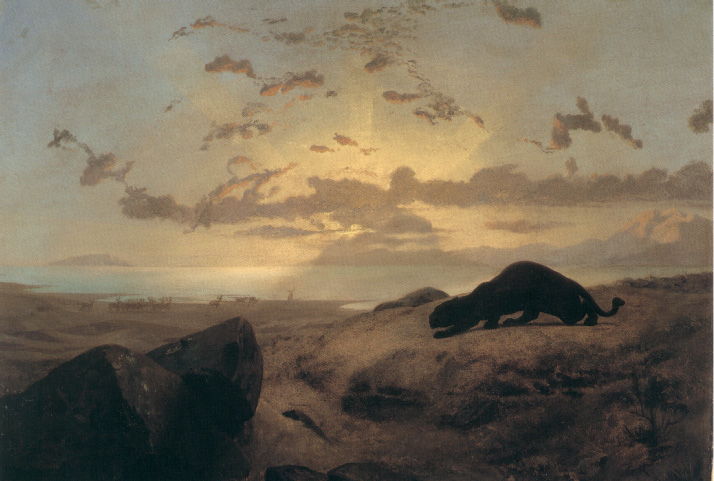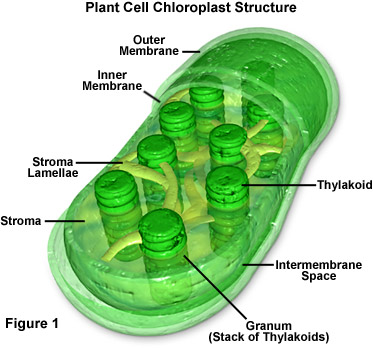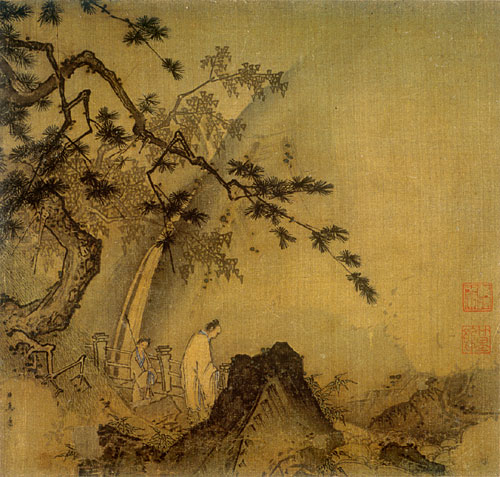Eating the Sun: How Plants Power the Planet. 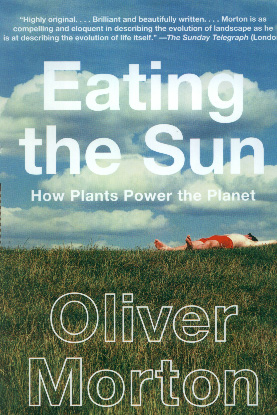
New York: Harper Collins, 2008.
"When the Calvin-Benson cycle turns carbon dioxide, from which living things can derive no energy, into carbohydrates, from which they can, it requires an energy source to do so."
p. 52
"The Calvin-Benson cycle is not free-wheeling; it needs to be driven. Photosynthesis is about more than just the cycle in which carbon is fixed. It’s about the energy that drives that fixation."
p. 52.
"Chlorophyll, the pigment that absorbs sunlight in plants, is based on a porphyrin cage for magnesium atoms and it is that magnesium which makes the pigment green."
p. 60.
"The early 1960s marked a cusp in the history of photosynthesis – what might be called the Great Clarification. Before it there was no coherent overview of the process. Afterwards there was. Hill's work on the Z-scheme and Duysen's work on photosystems were two parts of the Great Clarification. The third was to come...."
p. 84.
![]()
Key discoveries | Chloroplasts are? | Entropy | Light | Life | Water | Oxygen Event | Size matters | Geological time
respiration . . .took place not just in mitochondria, but in the membranes of mitochondria. ...sheets of tightly packed fatty acids
85
ATP and Chlorophyll
"A chloroplast is a bag inside a bag."
86
"The proteins that produce ATP in chloroplasts and mitochondria actually spin: each hydrogen ion that passes through one of the channels made of protein that are embedded in the membrane turns the rotor mechanism a bit further around."
In Humans
10 hydrogen ions - fully turn the crank producing 3 ATPs
"In plant chloroplasts, it take fourteen hydrogen ions to get a full turn and produce three ATPs. The little wheels spin round hundreds of times a second."
87
Key discoveries | Chloroplasts are? | Entropy | Light | Life | Water | Oxygen Event | Size matters | Geological time
"chlorophyll molecule sitting in a chloroplast"
"The chlorophyll absorbs the energy, which sets the chemical bonds that hold its atoms together thrumming. Its neighbors pick up on the vibration and start to vibrate in sympathy, and the energy gets passed from molecule to molecule through this resonance until it reaches a part of the photosystem where one of the chlorophyll molecules, rather than just resonates, actually loses and electron."
90
"The processes by which plants and algae capture and concentrate sunlight into chemical bonds are far, far more efficient than the processes by which it is made." (fusion)
91
![]()
Key discoveries | Chloroplasts are? | Entropy | Light | Life | Water | Oxygen Event | Size matters | Geological time
electrons want to move because of the Second Law of Thermodynamics to dissipate energy.
"Its the build-up of entropy that makes things irreversible, that gives things direction. It is entropy that gives the electrons flowing through the cytochromes a 'down' to flow to."
92
"that's what life does; it accepts the burden of entropy in order to take the benefits of energy. It then exports the that entropy while using the energy to arrange brute atoms in vast and intricate molecules, to line up cytochromes in membrane-bound chains, to corral hydrogen ions in tiny reservoirs, to store sugar as starch against the winter to build leaves . . . . To create interesting things on every scale from the pigment to the planet."
"The sun's energy, stored by plants, keeps us alive moment by moment, heartbeat by heartbeat, thought by thought. Our bodies are stardust; our lives are sunlight."
92
Key discoveries | Chloroplasts are? | Entropy | Light | Life | Water | Oxygen Event | Size matters | Geological time
"Photosystem II "the inner sanctum of photosynthesis."
Is comprised of:
19 nineteen separate proteins
36 thirty six chlorophyll molecules
coexist in a three dimensional jigsaw puzzle
98 & 136
Emerson and Arnold findings:
"They found that, when saturated with light, it took a staggering 2480 chlorophyll molecules to produce one molecule of oxygen."
104
"Since... [the discovery of ] the 137 atom chemical structure of chlorophyll in 1915 people have asked how it is that molecules in a cell can take the sun's light and use it to reduce carbon molecules"
p. 141.
"We do not know it all. But no human lifetime has ever taught us more. And in that, there is indeed and exquisite thrill."
p. 141.
"The hitherto unseen detail it provides on the little cluster of manganese atoms attached to the D1 protein which actually rips water [ H2O ] molecules apart. This oxygen evolving complex', it appears, grabs hold of two water molecules, pulls two hydrogen ions (and thus two electrons) from one, and then uses the extraordinary electron-hungry oxygen atom remaining to pull the hydrogen ions and electrons from the second water molecule, creating a two-atom oxygen molecule in the process. "
"All this is done with a little cluster of manganese ions positioned just so, their redox potential rising and falling in such a way as to pull the water associated with them apart." [OH from H]
137
![]()
Key discoveries | Chloroplasts are? | Entropy | Light | Life | Water | Oxygen Event | Size matters | Geological time
"Life is a flame with a memory."
"the isotope record assures us that, however they came about, by the Archaean there were microbes on earth, their biochemistry capable of distinguishing between light and heavy carbon."
165
Where respiration, for example, has reduced sulphates to sulphides, photosynthesis can reverse the process. It can fill the biosphere with things that will react together, providing new opportunities for life–while, in the process, challenging it to regulate the now unbalanced world it finds itself in."
167-68.
Acasta gneiss from Canada is only large remaining rock segments from the Hadean
"life maintains its inner order across cosmic spans of time."
168
"the bacteria are astonishingly good at finding energy that will let them make a living.
"This vast range of biochemical capabilities makes bacteria vital to the rest of life on earth."
"The endless stream of electrons running through these bacterial metabolisms provides the background hum of the earth's habitability."
169
"...the first photosystem was an adaptation of one of the protein way-stations on a bacterial electron transfer chain used in respiration."
169-170.
pigments possibly absorb "ultraviolet light" "defences against ultraviolet light"
170
photosystem I is found in purple bacteria and some relatives
photosystem II is found in green sulphur bacteria
171
"only cyanobacteria have both types, sprung together into a Z-scheme
172
"It was within the context of cyanobacteria, however they evolved, that photosynthesis made its great leap forward, and finally learned to use water as an electron donor. This moved life beyond the potential limits that might be imposed by scarcity...."
172
![]()
Key discoveries | Chloroplasts are? | Entropy | Light | Life | Water | Oxygen Event | Size matters | Geological time
"life has a non-negotiable need for water."
173
"the mystery of how the manganese cluster became incorporated into photosystem II is deeply intriguing and far from solved."
174
Photosystem II grew out of an earlier photosystem which shared its ancestry with a cytochrome."
[note: "A magnesium porphyrin complex is the heart of chlorophyll, the active molecule of photosynthesis. A magnesium porphyrin complex is the heart of chlorophyll, the active molecule of photosynthesis."
 biologically important molecule porphyrin
biologically important molecule porphyrin
See – http://www.physics.csbsju.edu/QM/H.11.html
"The porphyrins are actually an enormous group of organic compounds, found all over the living world. The special thing about porphyrins is that they bind metals. The four nitrogens in the middle of the porphyrin molecule act as teeth: they can grab and hold metal ions such as magnesium (Mg), iron (Fe), zinc (Zn), nickel (Ni), cobalt (Co), copper (Cu), and silver (Ag).[1]
See also – http://www.ratbehavior.org/porphyrin.htm
![]()
Key discoveries | Chloroplasts are? | Entropy | Light | Life | Water | Oxygen Event | Size matters | Geological time
"The Great Oxidation Event" – 2.4 billion years ago
p. 175
red (oxidized) sediments do not occur in the Archaean
rocks through out the Archaean have a full component of sulphur isotopes other wise unseen in Oxygen enriched atmospheres
176
"Photosystem II produces oxygen, and it is this oxygen which has pushed our current atmosphere so far and so tellingly away from chemical equilibrium. Oxygen is, in a way, the signature of the planet."
"...we can tell when oxygen first became a common component of the atmosphere – and it is well after the first evidence we have for the presence of cyanobacteria."
p. 175
![]()
Key discoveries | Chloroplasts are? | Entropy | Light | Life | Water | Oxygen Event | Size matters | Geological time
• "Photosynthesis, nature's greatest miracle."
oxidize means to remove a hydrogen from something
note: technically– undergo a reaction in which electrons are lost
oxidation of carbon ~> carbon dioxide S = sulphide
reduction of carbon ~> methane S = sulphate
182
"Archaea capable of making methane were among the first creatures on earth."
pp. 182-183.
"Because methane is light and has a low freezing point, in the Archaean it would have been able to rise to the top of the atmosphere."
183
"In the Archaean, when methane molecules would have lasted in the atmosphere for hundreds of thousands of years, their greenhouse power would have been greater."
183
"For the Archaean earth to have been something other than a lump of ice it would need a strong greenhouse effect."
as the sun was 1/4th weaker than it is today
"25% less sunlight would leave the earth infeasibly cold."
183
![]()
Key discoveries | Chloroplasts are? | Entropy | Light | Life | Water | Oxygen Event | Size matters | Geological time
Importance of positive feedback response cycles.
"This could well have set up what's known as 'positive feedback' a process in which the effects amplify the causes. More warmth, more biomass; more biomass, more methane; more methane, more warmth."
"the first great example of making the earth more habitable."
184
"As far as photosynthesis is concerned, oxygen is a potentially problematic waste product; but to the biosphere at large it is a great gift. The essence is... its great hunger for electrons"
185
"The Chemical shifts brought about by the Great Oxidation Event just after the end of the Archaean were not just biogeochemically fundamental. They were in all likelihood visible....For the first time since the dawn of the methane greenhouse – perhaps for the first time since the formation of the planet – the vault of heaven would have turned blue."
185
"Ferns and flamingos"...."no such creatures were possible before the Great Oxidation Event."
186
![]()
Role of O2, or oxygen in the oceans and air:
Oxygen as a "for all its electron-pulling power, it is remarkably stable."
"Oxygen is thus the best tool for excising electrons from other molecules that a planet could be expected to offer, a tool boasting a sharp edge, great ease of use, and a safety guard."
"single-celled".... "Such life is hugely important on a planetary scale– bacteria are still today responsible for almost all the biogeochemical recycling that keeps the earth habitable."
187
O2 "It would be evidence of a biosphere with enough power to move beyond microbes and into the realms of complexity which creatures like us inhabit – indeed evidence of what may be the only such type of biosphere the universe permits."
188
Key discoveries | Chloroplasts are? | Entropy | Light | Life | Water | Oxygen Event | Size matters | Geological time
The Goldilocks Hypothesis - it is just right
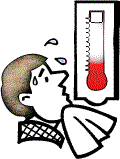 "One of the most striking discoveries made about the
earth in the past half-century is that it seems to have a natural thermostat.
"One of the most striking discoveries made about the
earth in the past half-century is that it seems to have a natural thermostat.
"As Harold Urey pointed out in the 1950s, when water and carbon dioxide are both present they turn silicate rocks–of which most of the earth's crust is made– into carbonate rocks, a process known as chemical weathering.
This weathering, like most chemistry, intensifies with rises in temperature. Put that temperature-dependence together with the fact that carbon dioxide can drive temperature changes by absorbing the earth's outgoing infrared photons and you have the potential for a negative feedback – a feedback in which the effects counteract the causes."
But when the planet gets warmer, chemical-weathering rates will increase, and the rate at which carbon dioxide is removed form the atmosphere will thus also increase. This increase in weathering works against the increase in carbon dioxide, pulling the temperature back down."
"Push the system one way, and it tries to push back- the harder you push the stronger the resistance."
"This thermostat . . . provides at least a partial explanation for the stability that the earth's climate shows over long stretches of time during which the sun has steadily been getting hotter."
"It allows" for both "greenhouse" and "icehouse" periods
p. 199.
"Without and effective carbon-dioxide greenhouse, though, the icecaps could under some circumstances just keep growing. The larger the icecaps the stronger the ice-albedo effect."
p. 200.
![]()
Key discoveries | Chloroplasts are? | Entropy | Light | Life | Water | Oxygen Event | Size matters | Geological time
"…the Great Oxidation Event … making possible the sort of large creatures we see around us today."
203
"Cyanobacteria (blue greens) can afford to be a bit bigger than the average bacterium, because folded photosynthetic membranes give them more energy per unit volume, and they thus can afford genomes complex enough to make different types of cell–a photosynthetic type and a nitrogen fixing type,which because of the sensitivities of nitrogen fixation has to be kept completely free of oxygen."
204
Eukaryotic cells get around the energy constraints by having discrete organelles within them that produce ATP."
ATP is adenosine tri-phosphate–the red and orange string on the tail of this molecule.
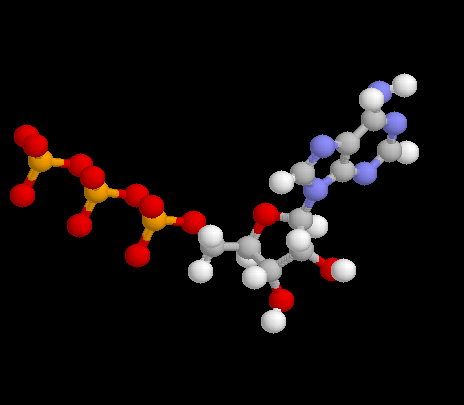
"These ATP-producing organelles are the mitochondria."
205
"But a world without mitochondria would lack large creatures able to make use of that oxygen."

205
fossil evidence "suggests that the mitochondrial endosymbiosis took place at a time quite close to the Great Oxidation Event."
205.
"chloroplast inhabitants"….
"But they are all descended from the same original ancestor."
209.
"The chloroplasts inside this network are now responsible for more of the world's primary productivity than the free-living cyanobacteria that have all the outside world in which to live."
210.
Proterozoic -- "boring billion" years -- was a nitrogen-starved world
211-212.
"...more erosion means more phosphates in the water running off the continents."
213-214.
"In today's marine ecosystems that limiting nutrient is usually phosphate."
214.
insufficient nitrogen (fixable or soluble form) available to proterozoic oceans
214.
"A sense of planet can amplify a sense of place."
"It ties the sky to the seed and the rain to the rock in a way that the details of a rustic experience cannot."
"life's nature needs to be captured at the levels of the molecule and the planet–at levels perceived by the intellect and not the senses...."
215
Geology reveals that for most of the time earth existed bacteria dominated life.

Comparative chart of geological time.
Are plants and animals merely a means of bacterial transportation?
The conditions on earth were and still are shaped by the totality of life:
"Your will not find the first land plants here. The fossil record is not the place to go for firsts. . . .
By the second, the Ordovician, some sediments contain spores almost sure to have come from plants."
pp. 218-219.
"The plants started more or less from scratch. The algae which sit closest to land plants on the tree of life are small and nothing much to look at. Their immediate descendants probably looked like tiny mosses, and would have been distinctly lacking in the sort of hard parts that stand a chance of fossilization."
219.
So what caused plants to "stand-up" and stretch for the sky?
Rhynie Chert, from Scotland -- findings are filled with plant fossils– 410 mya
220
"a golden world of tiny translucent beauties, a whole ecosystem captured in minute detail."
220
Key discoveries | Chloroplasts are? | Entropy | Light | Life | Water | Oxygen Event | Size matters | Geological time
a billion years before this cyanobacteria and "later lichens" had been photosynthesizers on the continents
now they (spores and seeds) were taking to the air
221
"Rootedness, an essentially soil-bound idea, is our primary metaphor for belonging."
221
"the soil is vital, mysterious and distinctive, it is also at some level, incidental."
"The trees purpose is the sky."
222
"Its growth looks less like something pushed from the earth than it does something drawn from the sky."
"Its limbs, branches and twigs spread into the air like ink into blotting paper, or cracks spreading through glass, embodying something between desire and transubstantiation."
...indeed, the soil is in large part made by the tree."
"The land is just a place to stand."
222
There are still plants that live like this today; the bryophytes, which include hornworts, liverworts and mosses, all tend to live low and flat, with only their spore for dispersal mechanisms standing proud of the moist surface.
223
Oliver Morton, Eating the Sun: How Plants Power the Planet. New York: Harper Collins, 2008.
Fritjof Capra, The Web of Life.
Marston Bates, The Forest and the Sea.
Eugne Odum, Natural Areas.
E. O. Wilson, The Diversity of Life.
Richard Dawkins, The Greatest Show on Earth.
